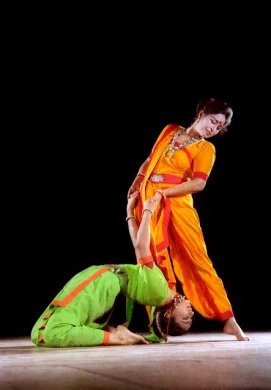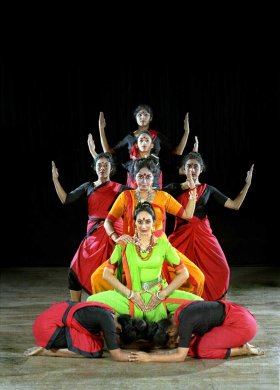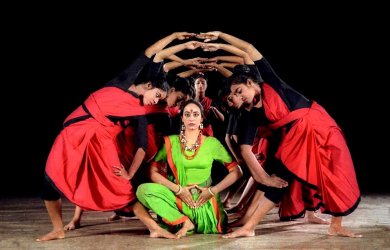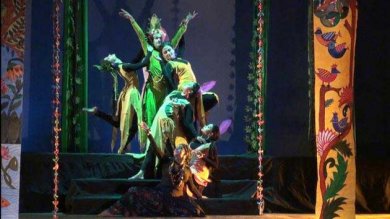
|   |

|   |
 e-mail: sunilkothari1933@gmail.com Remembering Manjusri Chaki Sircar September 19, 2016 Public memory is short. Dancers'Guild arranged a memorial lecture and presentation of one of the choreographic works Chitrangada, of late Manjusri Chaki Sircar, a dancer, choreographer, educationist, thinker and believer in extending the boundaries of dance, at Satyajit Ray Auditorium on the premises of Indian Council for Cultural Relations, Kolkata, on 4th September. Holding a PhD in Anthropology on the topic Women of Manipur, Manjusri, with MA from Presidency College in Bengal, went for further studies to Columbia University, USA. In 1945 she was one of the leading dancers in a team of progressive artists who believed in performing Gurudev Rabindranath Tagore's poems to the singing and compositions of Tagore's songs by George Da, Debabrata Biswas. They were all radical artists. Women dancers dared performing with men on equal terms and along with them. Manjusri held many radical views which found felicitous expressions in her later works on her return to Kolkata after a career as dancer and Professor in Anthropology at New Paltz University near New York. Tall, attractive, articulate and with a strong stage presence, Manjusri was influenced by Tagore's ideas of Modernism. It was not blindly following the West and following the traditional and classical dance forms without changing them or experimenting with them. They were resources which Tagore insisted upon exploring. Also to look at South East Asia, to the dance heritage of Java, Bali and also Sri Lanka. His daughter-in-law Pratima Devi had visited Europe with him and studied Modern dance from Mary Wigman of Germany. Tagore had on learning of Kathakali sent his prime disciple Santi Dev Ghose to Kerala Kalamandalam to study Kathakali. Tagore had invited Kelu Nayar, a Kathakali dancer, to teach Kathakali at Santiniketan. Having seen Manipuri at Sylhet he had invited a Manipuri guru to teach in the early twenties. It is now known to all that in Tagore's dance dramas both Manipuri and Kathakali were employed in the earlier stages. There were also a Mohinattam dancer and a Kathak dancer at Santiniketan. The dance dramas of Tagore had evolved as new genre of dance. Tagore's music composed by himself was the mainstay of these dance dramas along with his literary text, poems. On the two wheels of Rabindra Sangeet and dance drama, the chariot of Tagore's works used to stride across the sky. Artist Nandalal Bose, Pratima Devi used colourful costumes for the dance dramas Chitrangada, Chandalika, Tasher Desh, Mayar Khela. During the period of revival and renaissance of Indian classical dances, both Uday Shankar and Tagore had set in motion a trend of contemporary dance. Both were geniuses and aware of contemporary issues. In Chitrangada, she tells in the end revealing her own identity to Arjuna: "I am Chitrangada the princess, and not a Devi, or an ordinary woman; I am not one to be placed above and worshipped or to be left behind as a subordinate. Only when you let me be by your side in prosperity and adversity will you know me." This understanding of women's self reliance, self respect and independence appealed to Manjusri immensely.  Ranjabati & Manjusri as Prakriti & Maya 
 Tunnel scene-Ranjabati as Prakriti Tomari Matir Kanya Photos: Avinash Pasricha I saw Tomari Matir Kanya four or five times besides watching the rehearsals. She told me that she had edited the key dialogues with the musical effects for independent dance expression. She chose to show social turmoil by large group dances and chorus, a symbolic device to convey simultaneous multiple interpretations of the theme. Who can forget that amazing scene of human tunnel in Tomari Matir Kanya, which took the audience to an artistic domain far beyond the traditional narrative? She had choreographed it to show the transformation of childhood into womanhood. The power of women in religious spheres outside the Hindu Brahminic domain; the self reliance and self respect of the untouchable woman; and the force of the oppressed in revolt, were themes that appealed to her the most. She also was aware of the stranglehold of patriarchy, of Brahminism. Also as per her study of non-Vaishnavite Lai Haraoba dance form, she often used ritualistic elements in her dance dramas. She established Dancers' Guild in 1983 in Kolkata and for next seven years choreographed along with her gifted daughter Ranjabati Sircar, a series of choreographic works of outstanding quality. Ranjabati codified the Navanritya methodology, which she and Manjusri evolved for their dance and not following the routine blindly and what had lapsed into mediocre Rabindrik dance form. Her approach was radical and she believed in reinterpretation of Tagore's characters fully grasping what Tagore meant by 'chemical syntheses.' Creating Navanritya, Manjusri drew inspiration from the established classical styles like Kathak, Bharatanatyam, Kathakali, Manipuri, Odissi and forms like Kalaripayattu (martial art form of Kerala) and Thang-Ta of Manipur. She also drew from Mayurbhanj Chhau, movements which enhanced her concept of text of Tagore. She did not hesitate to draw from Kandyan dance of Sri Lanka. Her several works included War drums are sounding, Rudra Madhur, Yugsandhi, Meera Nrityakatha, Tasher Desh, Sabala, Shree O Shakti Rag O Rupantar, Aranya Amrita and Charaibeti. What is striking about Manjusri's choreography is her ability to emote the words and the basic mood of literature through a total body language. Instead of relying on hasta mudras, hand gestures and sattvikabhinaya, the inner feeling of each movement which registers in the body and face, she steered clear of the pressure of classical or Tagorean dance culture. Though she drew from the classical source, eclecticism for her was the first step in the evolution of her style. Whereas Rabindra Sangeet and the music Gurudev himself composed for his dance dramas are enjoyed by one and all, the dance vocabulary used in a mindless manner by the majority of dancers is not appreciated by the community of classical dance exponents. In that context, both Manjusri's and Ranjabati's choreographic works stand out for inherent dignity, strength, vigour and technique developed by them.  Chitrangada I attended their regular classes held at her residence by Jonaki Sarkar and other colleagues Rabishankar Roy and Prabir Mandal, reminding me of the original movements codified by Manjusri and Ranjabati. Also in presentation of Chitrangada, all those movements were incorporated. Aushika Chakravarty, another brilliant disciple of Manjusri, has helped them in re-choreographing it. It created nostalgia for me. My only criticism was that it had over decoration and it should be eschewed. Mithun Banerjee as Arjun, Sadhana Hazra as Kurupa, Arpita Dutta as Surupa, Rabishankar Roy as Madan and Prabir Mandal as Basanta and other female dancers did justice to original choreography, except that now they do not have to use pata painting scroll of Chitrangada on either side, as it limits the space for dancers to perform. The building which Manjusri had started for Dancers' Guild titled Mrittika is now ready in Salt Lake with several rooms and an auditorium. Classes will now be held there also after its formal inauguration in December this year. Parbati Gupta, the secretary of Dancers' Guild, has stood from the beginning by Manjusri Chaki Sircar. With Jonaki Sarkar as lead choreographer practising the repertoire regularly with the company, Navanritya methodology and performances take place regularly in Kolkata. They have some excerpts of a film Arghya by Devaki Bose in which Manjusri as a young dancer performs and also some excerpts of Tomari Matir Kanya which were screened and I saw the magic of Tomari Matir Kanya based on Chandalika, of the tunnel sequence in which Ranjabati as Prakriti passes through as a rite of passage. ICCR has sponsored their tour to Napier University, Edinburgh, with performances and workshops and also in London at The Nehru Centre. There are plans to bring some productions to New Delhi with separate workshops of Navanritya to pay tribute to Manjusri and Ranjabati.  Dr. Sunil Kothari is a dance historian, scholar, author and critic. He is honored with Padma Shri, Sangeet Natak Akademi award and Senior Critic Award from Dance Critics Association, NYC. Post your comments Please provide your name and email id when you use the Anonymous profile in the blog to post a comment. All appropriate comments posted with name & email id in the blog will also be featured in the site. |